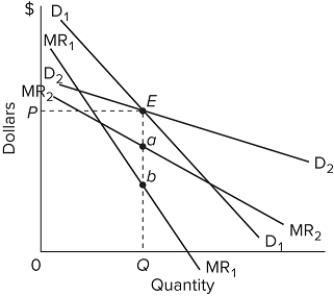Multiple Choice
 Refer to the diagram for a non-collusive oligopolist. Suppose that the firm is initially in equilibrium at point E, where the equilibrium price and quantity are P and Q. Which of the following statements is correct?
Refer to the diagram for a non-collusive oligopolist. Suppose that the firm is initially in equilibrium at point E, where the equilibrium price and quantity are P and Q. Which of the following statements is correct?
A) Demand curve D₁ assumes that rivals will match any price change initiated by this oligopolist.
B) Demand curves D₁ and D₂ both assume that rivals will ignore any price change initiated by this oligopolist.
C) Demand curves D₁ and D₂ both assume that rivals will match any price change initiated by this oligopolist.
D) Demand curve D₂ assumes that rivals will match any price change initiated by this oligopolist.
Correct Answer:

Verified
Correct Answer:
Verified
Q140: When oligopolists collude, they collectively tend to
Q141: Unlike a monopoly, an oligopoly tends to
Q142: Mutually cancelling advertising by oligopolistic firms tends
Q143: Collusion refers to a situation where rival
Q144: Assume six firms composing an industry have
Q146: A prediction from the kinked demand curve
Q147: Which of the following best describes a
Q148: Negative-sum games do not exist, because neither
Q149: Advertising can impede economic efficiency when it<br>A)reduces
Q150: The U.S. breakfast cereal industry is an